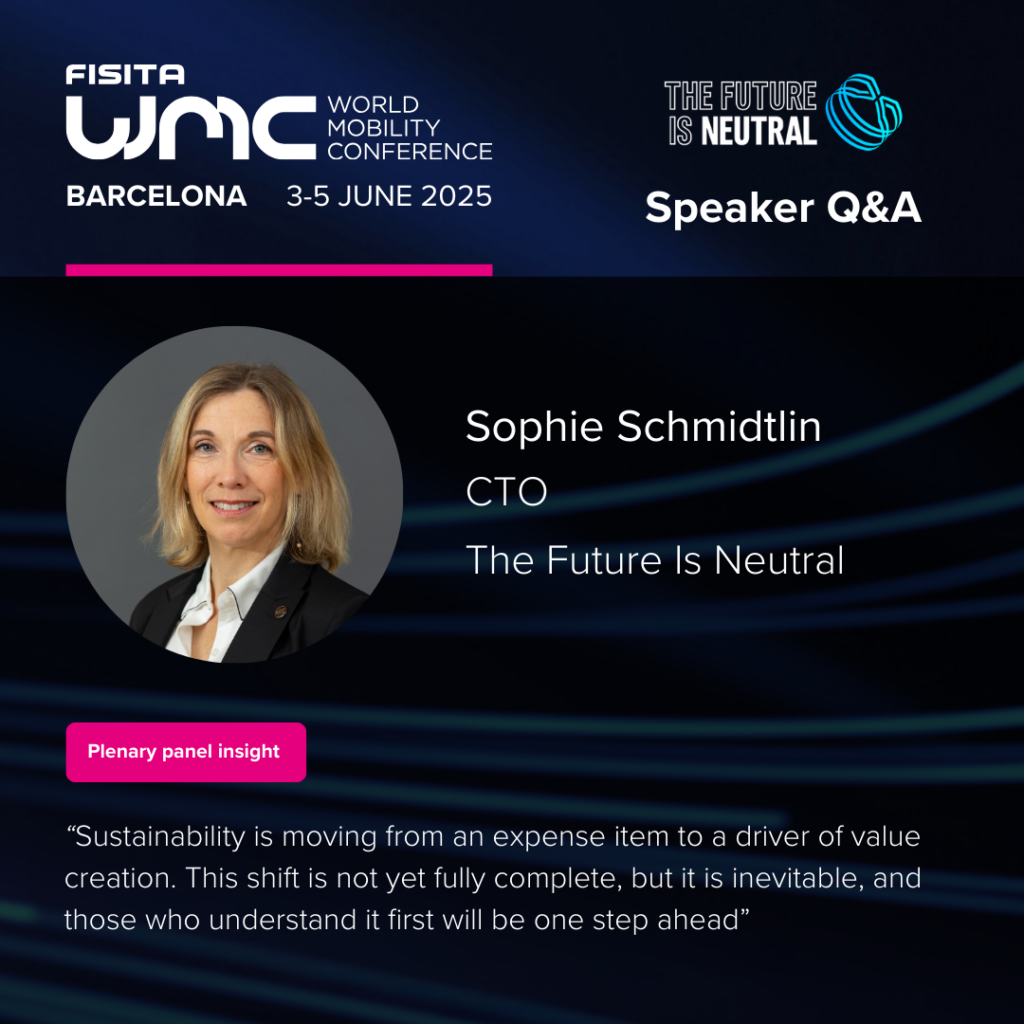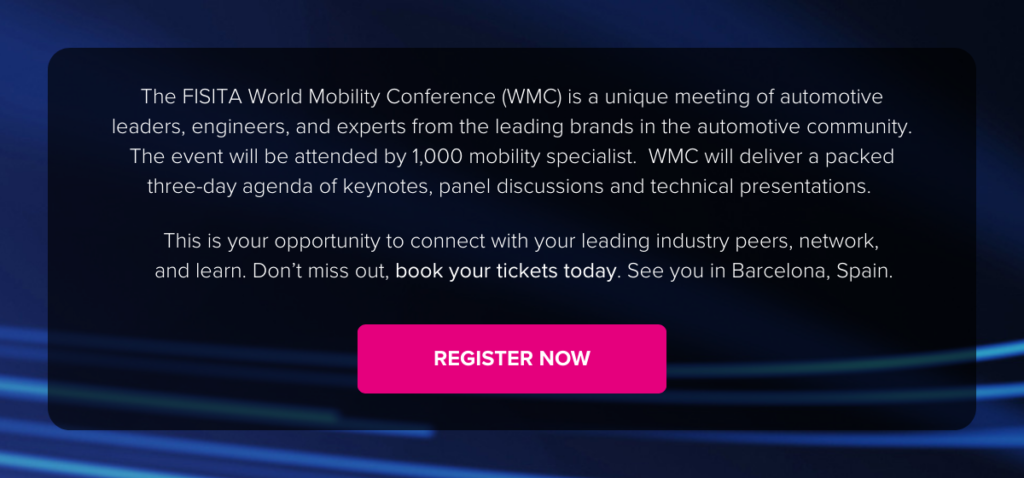Sophie Schmidtlin, CTO, The Future is Neutral talks to FISITA CTO Martin Kahl about sustainable mobility and the circular economy
One of the highlights of the 2025 FISITA World Mobility Conference will be the plenary panel discussion on sustainability and circularity in the automotive industry, featuring experts from The Future is Neutral, Geely Holding, Toyota Motor Europe, and Robert Bosch.
Sophie Schmidtlin began her career within the Renault Group in Powertrain engineering, later becoming Chief Engineer for C-segment SUVs, and then VP of Research and Innovation. As the Chief Technology Officer for The Future is Neutral, the circular economy company launched by Renault Group with recent investment from SUEZ, Sophie’s focus is on the technical challenges and opportunities of circular economy activities in the automotive industry.
Sophie chairs the FISITA Circular Economy Expert Group, and will participate in the FISITA WMC plenary panel on “Sustainable mobility and the circular economy,” alongside Dr Yuan Shen, CTO at Geely Holding, Umit Sengezer, Head of Circular Economy at Toyota Motor Europe, and Peter Lukassen, Director, Sustainability at Robert Bosch.
Ahead of her appearance at the conference, FISITA spoke to Sophie about some of the key topics of the panel.
Automotive is one of the most disruptive and disrupted industries; from your perspective, is sustainability being sufficiently embraced as a business strategy, or still seen as a compliance cost – and how do you see this changing?
That’s a very good question, and one that touches on a real strategic dilemma for the automotive industry. The cursor is moving between economic survival and environmental responsibility, but not always fast enough.
Sustainability is moving from an expense item to a driver of value creation. This shift is not yet fully complete, but it is inevitable, and those who understand it first will be one step ahead
Currently, sustainability in the automotive industry still oscillates between two visions: a compliance obligation, to meet increasingly stringent environmental regulations such as emission standards and Extended Producer Responsibility, and a strategic lever to create long-term value, to differentiate itself and to meet the growing expectations of consumers, as well as investors.
That said, this view is changing rapidly. Manufacturers are in transition, increasingly adopting a strategic approach, communicating on their carbon neutrality, their circular vehicle projects, or shared mobility.
Sustainability is moving from an expense item to a driver of value creation. This shift is not yet fully complete, but it is inevitable, and those who understand it first will be one step ahead.
Electrification is just one way in which automakers can achieve cleaner mobility; what else should the industry consider in the quest to reduce the environmental impact of mobility?
Electrification is an important lever, but it is not a miracle solution. To truly reduce the environmental impact of mobility, the automotive industry needs to take a systemic approach.
Most importantly, we must not limit ourselves to the emissions in use but consider the entire life cycle of the vehicle, from extraction of raw materials, manufacture of the vehicle and its components in particular the battery, the use phase including electricity consumption and energy used, and end of life handling, notably recyclability and second life of batteries.
The circular economy requires moving from linear supply chains to closed loops, requiring reverse logistics, efficient traceability, and collection systems. It also requires forging partnerships with players outside the automotive industry, such as waste managers and recyclers
Beyond life cycle analysis, or LCA, I am convinced that it is important to focus on the circular economy: extending the life of vehicles through repair, reuse and remanufacturing of parts, and second life, recycling materials to reduce the pressure on natural resources.
Eco-design will greatly improve the performance of the circular economy.
Circular economy is becoming an accepted business practice in the automotive industry, but it’s far from maturity. How easy is it to build circularity into mass-market business models and into mainstream manufacturing processes and operations?
Indeed, the circular economy represents a major opportunity for the automotive industry, but its large-scale integration is anything but simple.
Just one example to illustrate this: the circular economy requires moving from linear supply chains to closed loops, requiring reverse logistics, efficient traceability, and collection systems. It also requires forging partnerships with players outside the automotive industry, such as waste managers and recyclers, and mastering the entire value chain to be able to reintegrate recycled material into new vehicles.
Indeed, this challenges the current economic model, which traditionally still relies heavily on the sale of new vehicles. The circular economy is pushing for the adoption of usage-based models, such as long-term rental, subscription, or shared mobility.
What can the automotive industry learn from other industries about sustainability and circular economy? And what can other industries learn from automotive?
It is true that the exchange of good practices between industries could accelerate the transition to a more sustainable model.
The current economic model traditionally still relies heavily on the sale of new vehicles. The circular economy is pushing for the adoption of usage-based models, such as long-term rental, subscription, or shared mobility
The automotive industry could undoubtedly take an interest in sectors such as fashion—think of Patagonia and Veja—or electronics companies such as Fairphone, which are developing very advanced models of repair, reuse, and recycling. The car industry can be inspired by these initiatives to modularize parts, facilitate vehicle repairs, and encourage deposit or component return systems.
Conversely, some manufacturers conduct in-depth LCAs. This holistic approach could be better adopted in industries such as tech or fashion, where this is just starting to be adopted.
You’re a panellist at the FISITA World Mobility Conference. What will be your key message to delegates?
My main message will be to encourage delegates to take an interest in and invest in circular economy solutions, illustrated with concrete examples. This will only be a foretaste of the communication that the FISITA Circular Economy Expert Group is preparing with a dedicated Circular White Paper. Because I think that circular economy solutions represent the future of a planet whose resources are not unlimited, and that they are aligned with societal expectations too.

